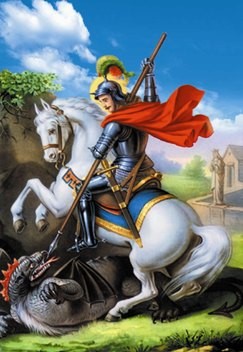

According to the tradition, St. George was a soldier in the army of the Roman emperor Diocletion. During the persecution of Christians by the emperor, St. George was tortured and finally he was martyred in the year AD 303 on 23rd April. The most famous tradition about St. George is the slaying of the snake – dragon and saving the young girl – the daughter of the king, who was offered as a sacrifice to the snake. Almost all of the Saint’s icons and images depict this event. Due to his military background, St. George is venerated as a military saint. He is also the patron saint of many countries like England, Georgia, Malta, Ethiopia etc.
St. George is one of the most venerated saints of Christianity, and is venerated by Catholics, Eastern and Oriental Orthodox churches. He is even considered a saint by many Muslims and his tomb in Lod (Israel) consists of both a church and a mosque built next to each other.
Malankara Orthodox Church has numerous churches named after the saint, notably the churches in Puthuppally, Kadamatom, Cheppad etc. To show the devotion and as a sign of thanksgiving, it is a common practice to name their sons under the saint’s name. George, Geevarghese, Varghese, Varkey, Vareeth etc are all various variants of the saint’s name and are very common among Malankara Nasranis. It may be noted that the first name of many past and present Metropolitans of our church is “Geevarghese”, including Parumala Thirumeni.
St. George is the patron saint of our church in Abu Dhabi and is named after him – St. George Orthodox Cathedral. For us, members of this parish, the devotion to our patron saint is very personal. There is hardly anyone who hasn’t received blessings through the intercession of St. George. Our parish celebrates the feast of the saint on 23rd April each year.
